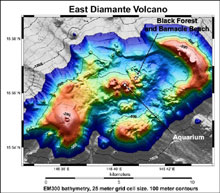
The summit of Diamante volcano, created from an EM300 grid. The bathymetry data were collected on the Submarine Ring of Fire 2002 and 2003 expeditions. The major vent sites visited on dives R787 and R788 are noted. Click image for larger view.
East Diamante Volcano: Another Amazing Place on the Mariana Arc
April 5, 2004
Bob Embley
Chief Scientist
Pacific Marine Environmental Laboratory
NOAA Vents Program
![]() A close encounter with an angel fish as it swims by a black smoker. (mp4, 1.4 MB)
A close encounter with an angel fish as it swims by a black smoker. (mp4, 1.4 MB)
![]() Sea life around the hydrothermal vents at the East Diamante volcano (mp4, 5.2 MB)
Sea life around the hydrothermal vents at the East Diamante volcano (mp4, 5.2 MB)
It was difficult for us to leave NW Rota 1 and the Brimstone Pit area, knowing that it may have been the first time submarine volcanic activity was witnessed as it was happening. We didn’t know if our next site, East Diamante volcano, would be equally exciting, but we steamed north with hopeful anticipation. The summit of this large volcano is topped by an ancient caldera, collapsed in the center and with heavily eroded rims, suggesting that the volcanic activity sputtered out long ago. This aged appearance made our detection of a strong hydrothermal plume in 2003 that much more enigmatic. The plume found in 2003 surrounded a group of small lava cones near the center of the caldera. Magmatic events, over the course of thousands of years, can build a central dome complex. Each small volcano may be equivalent to a different eruptive episode. Our CTD team provided clues to which of the domes might likely be the sources of the venting. The depth of the major plume was at 320 m (1,050 ft) depth, so the source had to be deeper than the plume horizon.
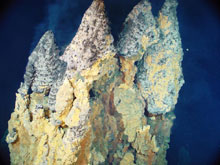
Active “smoker” chimneys precipitating iron, copper and zinc sulfides from 230ºC fluid. They are 9 m tall from the base to the top of the chimneys. Click image for larger view and more details
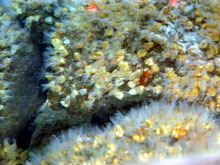
Close-up of a vent barnacle that we’re currently trying to identify. The furry things are their little legs (cirri) that capture food particles. The density of barnacles was so extreme here that there was little room for other organisms. Click image for larger view and more details
We were in for two major surprises during a stunning discovery dive. After reaching the sea floor, low-temperature diffuse venting was quickly recognized amidst the boulder-strewn slope. The presence of barnacles (possibly a new species) coined the name of the first site as “Barnacle Beach." After a short search around the rim of the cone, we came across a line of sulfide chimneys (named the “Black Forest”) upslope of Barnacle Beach. These represented the first sulfide-depositing hydrothermal systems found along the Mariana Volcanic Arc. They may also be the shallowest active sulfide vents yet seen. The mineralogy and metal content of the deposits are of great interest to those studying the formation of ore deposits found on land.
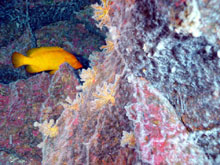
Chemosynthetic microbial mats cover red algae and coral, which are photosynthetic. Hydrothermal vent and coral reef communities are overlapping here at 190 m depth. Click image for larger view and more details.
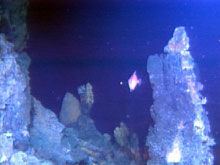
This may be a unique photograph of a shallow-water tropical fish swimming among active black smoker chimneys at Black Forest vent field. The chimneys rise up to 7 m tall. Click image for larger view.
From the first site we proceeded west to a cone that rises to 168 m, named “Pinnacle Cone." The first surprise was to find the slope of the cone completely covered with a thin, filamentous microbial mat. Rising up to 200 m depth, we began to see red and green encrusting algae on surface of the rocks. The microbial mats party covered these surfaces as well. This site is a unique environment where a chemosynthetic ecosystem (represented by the microbial mat) intersects with the photosynthetic ecosystem of the shallow ocean. This juxtaposition of two ecosystems was of great interest to the biologists on board (Kim Juniper, Verena Tunnicliffe, Anna Metaxas, and John Dower). At this depth, the ROPOS ROV (remotely operated vehicle) could “see” using only the filtered sunlight from the surface. The top of the cone consisted of several large pinnacles of volcanic rock with vertical walls. A myriad of fish, basket sea stars, various types of corals, and other organisms populated the spires. We named the site “Aquarium” for its colorful variety of sea life.

This stunning image of the Aquarium site shows the picturesque gully with its abundant sea life, which includes algae (red and green), soft corals (pink with white stalks) and tropical fishes. Click image for larger view.
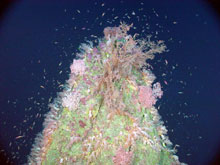
This pinnacle rises to 167 m below the surface. The coiled up pink masses are basket sea stars (about 50 cm across). A myriad of small fish, probably wrasses, swarm around the top of Pinnacle Cone. Click image for larger view and more details.
We’re now headed north to Maug, a mile-wide caldera surrounded by the remnants of a massive volcanic event that occurred thousands of years ago. These remnants form a circle of three small islands guarding the shallowly submerged caldera floor. This site yielded one of the most intense plumes found in 2003. Who knows what we will find on the sea-floor rocks of Maug?
Sign up for the Ocean Explorer E-mail Update List.



























